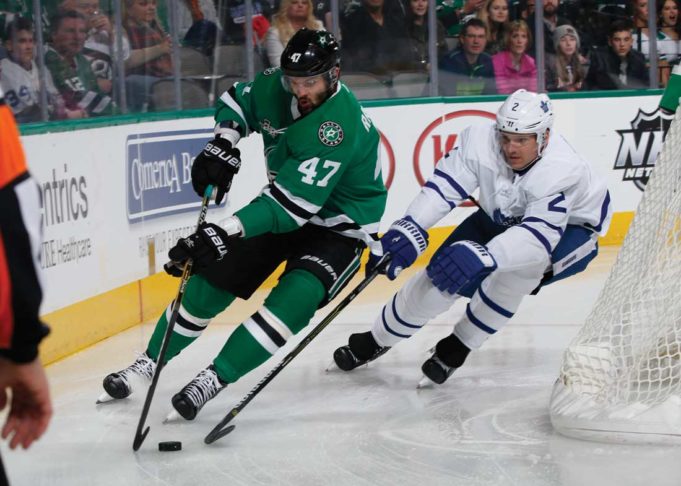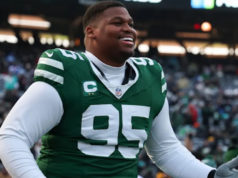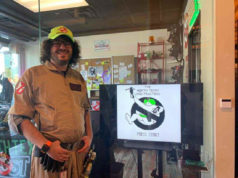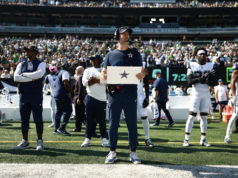Before Friday night’s game, the Dallas Stars honored former player Jamie Langenbrunner as part of their celebration of the 25th anniversary of the team’s move from Minnesota to downtown Dallas. The right-winger joined the organization that same year, when the Stars selected him in the second round of the 1993 NHL Entry Draft. While the 18-year-old Langenbrunner honed his skills with his junior hockey team in Peterborough, Ontario, the big club surprised many by making the playoffs in 1994 after having missed them the previous year in Minnesota.
This year’s group had hoped to repeat its predecessors’ performance of two and a half decades ago by returning to the postseason after missing it in 2016-17. That desired outcome is in grave doubt as the regular season enters its final two weeks. One man who has watched each of this season’s tilts from the Stars’ broadcast booth also played in every game for that first Dallas team: Craig Ludwig.
This past offseason, Ludwig saw the Stars make moves they hoped would position them for success. They added a high-scoring forward in Alexander Radulov, a frontline defenseman in Marc Methot, a big face-off specialist and second-line scorer in Martin Hanzal, and a man Ludwig suggested has “arguably been one of the top five to 10 goaltenders in the league” over the past few years, Ben Bishop. (He did lead the league in goals-against average two years ago.) Those players would supplement a talented core that includes former scoring champion Jamie Benn, speedy and gifted center Tyler Séguin, four-time All-Star center Jason Spezza, and one of the league’s most skilled defensemen, John Klingberg. Though the team has had a pair of five-game winning streaks and stretches where they looked like they could beat anyone, the season has not played out as hoped.
“Earlier in the season, this team was better positioned,” Ludwig said. “Injuries is kind of what happened.”
Methot and Hanzal have participated in only 30 and 38 games, respectively, out of the 75-plus the Stars have played so far. Spezza has missed time recently, and, most devastatingly, Bishop has played only 10 minutes since March 16. Bishop hurt his left knee early in the month, missed five games, and aggravated the injury during his return to the lineup. The rise in doctor visits corresponded with a drop in the team’s position in the standings.
NHL teams compete in two conferences, with eight teams from each earning a chance to play for the Stanley Cup awarded to the league’s champion. The Stars had occupied one of the final two Western Conference playoff spots for much of the season, but when they pulled only two points in the standings from a recent six-game road trip, it dropped them into 10th. They’re in a five-way fight with Anaheim, Colorado, Los Angeles, and St. Louis for a spot in the postseason tournament. A team receives two points for a win, one if they lose in overtime or the penalty shot shootout that results from a scoreless OT. A regulation loss yields no points. The Stars earned only four points in road games in March, all via losses in extra time. Home losses this past weekend to Boston and Vancouver have put them on the brink of an early summer vacation.
Even if the Stars rally to grab the eighth seed in the West, they would face a first-round matchup with the conference’s top seed, most likely last year’s Cup finalist, the Nashville Predators. Though it’s not unheard of for a low seed to fight its way through two months of playoff hockey, it’s highly unlikely, especially with a depleted roster.
“I’m not going to sit here and say that we’re a team that’s in a position right now to go to the finals,” Ludwig said. “It just wouldn’t be realistic to say.”
If they won’t make noise in the playoffs this year, the question arises: When will they? Ludwig despises terms like “rebuild” or “retool.” He thinks the Stars aren’t that far away from contending, though, and a man Ludwig knows well is one of the reasons. After last year’s disappointing finish, Dallas made changes off the ice in addition to adding players. They brought back a man who had coached Ludwig, Langenbrunner, and other Stars icons through the most successful years in franchise history. They hired Ken Hitchcock.
The Edmonton native started with the franchise in 1993, too. The general manager at the time, Bob Gainey, hired him to helm the club’s top minor league affiliate, which played in that era in Kalamazoo as a member of the since-folded International Hockey League. Langenbrunner played 11 games there for Hitchcock in 1994-95 before moving on to the NHL. The coach got his own promotion when he took over the Stars’ head coaching duties in 1996. His tenure lasted until 2001 and included the team’s only Stanley Cup win, in 1999. The coach’s return had little to do with 25th anniversary nostalgia and a lot to do with the club’s desire for him to implement his hard-charging yet defensively responsible style of play.
“Ken Hitchcock didn’t come here at 66 years old and 800 and how many ever wins he has [819 as of press time] to be in a rebuilding team,” Ludwig said. “You know he’s here to win.”
Furthermore, Ludwig believes the team’s players have bought into the system Hitchcock used to help earn Ludwig a second Stanley Cup ring. (The defenseman also won one with Montreal in 1986.) He cited young center Radek Faksa as a young player who has improved enough that Hitchcock can match him defensively against the opposition’s best forwards. He credits Rick Wilson, who coached the defensemen for the Cup-winning team and now does so again, for helping the offensively creative Klingberg become more reliable defensively. Perhaps most importantly, Hitchcock has helped the man with the talent to excel at all phases of the game start to do so.
“Tyler Séguin has been fantastic all season long,” Ludwig said. “Hitchcock asked him to be a more rounded player, and he bought right into that, and he’s getting rewarded on the offensive side. He’s been the go-to guy from face-offs, the penalty kill, power play, five on five.”
Ludwig has seen the team give the all-out effort Hitchcock demands. They just haven’t had sufficient depth of talent, especially after the injuries.
“You can’t lean on three guys up front all the time – Benn, Séguin, Radulov – and that’s what we’ve done,” said Ludwig of a team in which those three players plus Klingberg have each exceeded 60 points (goals plus assists) on the year while no other player has approached 40. Of the newly acquired Radulov, Ludwig noted, “I don’t know how this guy can play all 82 games the way that he plays, because he empties his tank every single shift – not just every game, every single shift. He gives you everything.”
As the Stars move into the offseason, they’ll need to determine how to find supplemental talent. During Hitchcock’s first tour in Dallas, they added front-line players like Joe Nieuwendyk, Ed Belfour, and Brett Hull, as well as depth contributors with leadership skills like Guy Carbonneau, Mike Keane, and Brian Skrudland. Facing a salary cap their 1990s predecessors didn’t have to deal with, current GM Jim Nill’s braintrust will have to determine this offseason whether they can sign, draft, or trade for the types of players who will help the Stars quickly take the next steps.
In building the Stars’ championship club, Ludwig recalled, Gainey formulated a veteran team accustomed to playoff tension. If the Stars did eke out a playoff berth this season, that experience could prove invaluable to young players like Faksa, Klingberg, and Stephen Johns, as ’90s playoff runs no doubt did for the likes of Langenbrunner, Richard Matvichuk, and Jere Lehtinen. Perhaps they’ll decide to acquire postseason-hardened veterans to expedite their journey to contending, in part due to Hitchcock’s age. (He turns 67 in the middle of next season.) The defenseman-turned-broadcaster sees signs the Stars might have the core to make it happen.
“The majority of Stanley Cup contenders, you’re going to have three guys: one guy that’s up for the Vezina [Trophy] for the best goaltender in the league, one guy that’s up for the Norris for the best defenseman in the league, and one guy who’s up for the Selke,” officially for best defensive forward but often awarded to a top all-around center. A healthy Bishop, Klingberg, and Seguin could give the Stars those components. Can Nill, Hitchcock, and company fill in the roster around them? We’ll know they did so successfully if we see those acquisitions dropping ceremonial first pucks 25 years from now.












